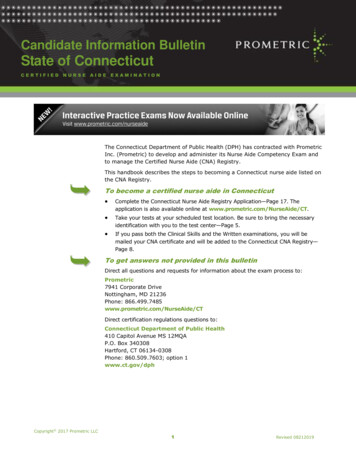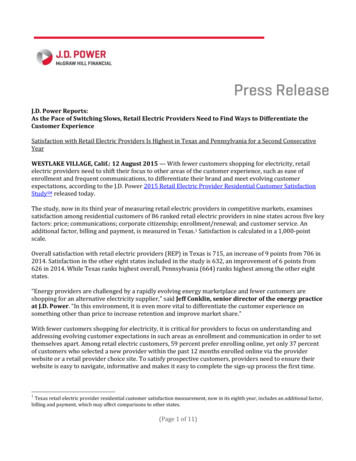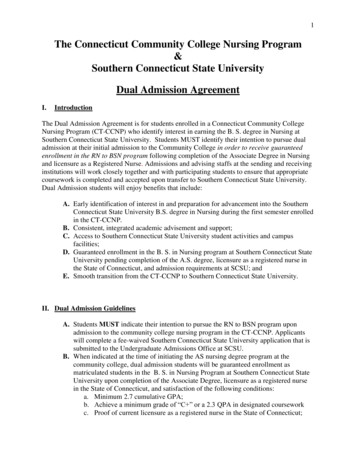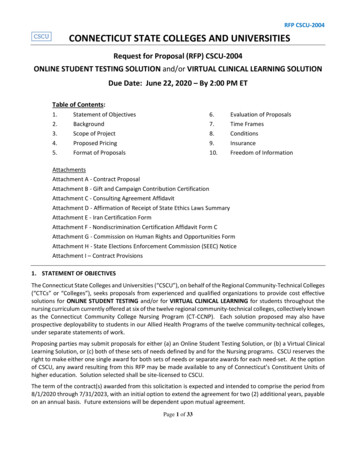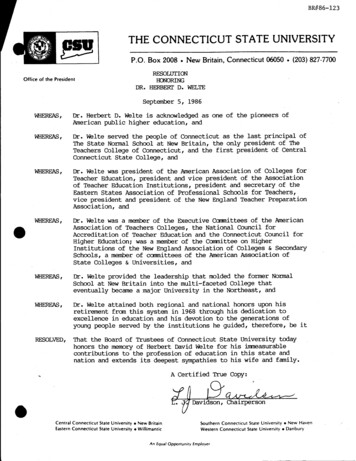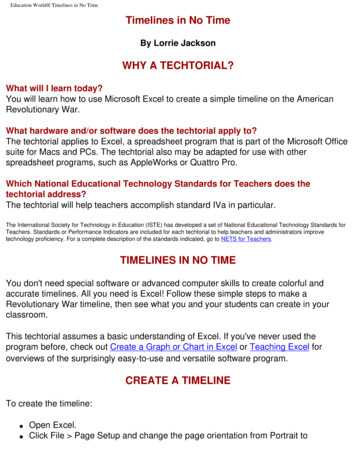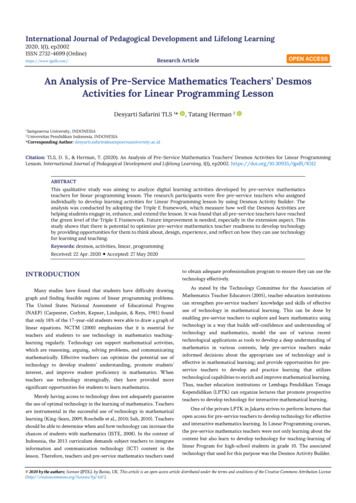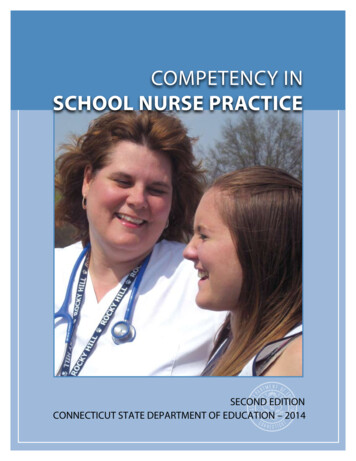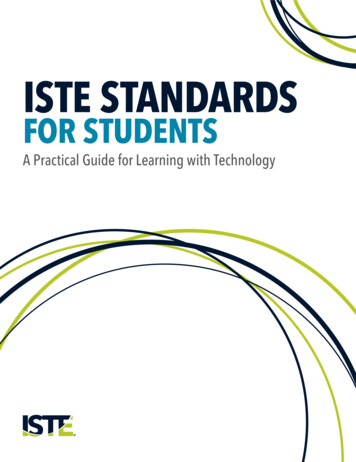
Transcription
ISTE STANDARDSFOR STUDENTSA Practical Guide for Learning with Technology
ISTE STANDARDSFOR STUDENTSA Practical Guide for Learning with TechnologyAbout ISTEThe International Society for Technology in Education is the premier membership association for educators and educationleaders committed to empowering connected learners in a connected world. Home to the ISTE Conference & Expo and thewidely adopted ISTE Standards for learning, teaching and leading in the digital age, the association represents more than100,000 professionals worldwide.We support our members with professional development, networking opportunities, advocacy and edtech resources tohelp advance the transformation of education. To find out more about these and other ISTE initiatives, visit iste.org.What are the ISTE Standards?The ISTE Standards are the standards for learning, teaching and leading in the digital age and are widely recognized andadopted worldwide. They work together to transform education. iste.org/standards 2017 International Society for Technology in EducationWorld rights reserved. No part of this book may be reproduced or transmitted in any form or by any means — electronic, mechanical,photocopying, recording or by any information storage or retrieval system — without prior written permission from the publisher.Library of Congress Cataloging-in-Publication Data available.First EditionISBN:978-1-56484-398-2Printed in the United States of AmericaISTE is a registered trademark of the International Society for Technology in Education.
ForewordWelcome to the ISTE Standards for Students, your road map to transforming learning and teaching alongside today’sconnected learners.These standards are designed to empower students to be owners of the learning process and ensure that learning is ablend of exploration, creativity and discovery. They are about meeting the needs of learners who live, work and play in aglobally connected world.Empowered Learner. Digital Citizen. Knowledge Constructor. Innovative Designer. Computational Thinker. CreativeCommunicator. Global Collaborator.The names of the standards point to both the functional and aspirational roles of today’s learners.In this guide, you’ll find definitions of each standard along with scenarios for authentic learning activities that buildstudents’ essential skills, a crosswalk comparing these standards to previous iterations, and a prerequisite foundationaltechnology skills scope and sequence document – all designed to show you what the Student Standards look like inpractice.I want to express my sincere appreciation to the thousands of educators and hundreds of students who contributed to theStudent Standards. Their input was invaluable in the creation of these exciting standards that are giving a voice to learnersaround the world.Richard CulattaISTE CEOUsing this bookletThis booklet is your guide to the refreshed standards. The standards are presented amid content that defines andcharacterizes them and answers the important question, what do the ISTE Standards for Students look like in practice?In the following sections you will find: The ISTE Standards for Students. Nine scenarios describing authentic learning activities that build Student Standards skills. Skills by age band for what can be expected to support design of learning activities. A crosswalk comparing the ISTE Standards for Students (2016) to the ISTE Standards for Students (2007). A prerequisite foundational technology skills scope and sequence table.ISTE Standards for Studentsi
PrefaceThe ISTE Standards are about learning, not tools. They reflect and further a shared goal to bring deep, transformativelearning to our students. They were developed for educators by educators. Practitioners use them to guide empoweredstudent learning, and leaders rely on them to advance an innovative vision for learning with technology.Make the standards work for you If you’re an educator, use the standards to guide your learning design, inspire your professional growth andadvocate for dynamic learning in your school. You can find support and resources at iste.org/standardsforstudents. If you’re an education leader, use the standards to guide your vision and goals around digital learning andteaching, using them to support systemwide plans — including professional growth, school improvement andtechnology plans as well as curriculum mapping — or in your LMS or web system. A decision to use in any oneof these ways is considered an adoption by ISTE. To help you on your way, access the free report, “Redefininglearning in a technology-driven world: A report to support adoption of the ISTE Standards for Students” atiste.org/StandardsReport.Help ISTE support you Educators can download the standards using the permissions process, which contributes to rich data that ISTE useswhen designing resources and making the case for the standards. With permissions, you also receive a PDF of thestandards, a toolkit to support your use and other resources as they become available. Leaders, share your story. Let ISTE know about your decision to adopt the standards so we can support your efforts,measure the impact of the standards and share your success. Take this short survey at iste.org/StandardsSurvey.Questions, ideas or suggestions? Share them with standards@iste.org.iiISTE Standards for Students
ContentsForeword. . . . . . . . . . . . . . . . . . . . . . . . . . . . . . . . . . . . . . . . . . . . . . . . . . . . . . . . . . . . . . . . . . . . . . . . . . . . . . . . . . . . . . . . . . . . . . . . . . . . . . . . . . . . . . . . . . . . . . . . . . . . . . . . . . . . . . . . . . . . . . . . . . . . . . . . . . . iPreface. . . . . . . . . . . . . . . . . . . . . . . . . . . . . . . . . . . . . . . . . . . . . . . . . . . . . . . . . . . . . . . . . . . . . . . . . . . . . . . . . . . . . . . . . . . . . . . . . . . . . . . . . . . . . . . . . . . . . . . . . . . . . . . . . . . . . . . . . . . . . . . . . . . . . . . . . . . . . iiIntroduction: Realizing the Promise of Technology . . . . . . . . . . . . . . . . . . . . . . . . . . . . . . . . . . . . . . . . . . . . . . . . . . . . . . . . . . . . . . . . . . . . . . . . . . . . . . . . . . . . . . . . . . . . . . . . . . . . . 1ISTE Standards for Students. . . . . . . . . . . . . . . . . . . . . . . . . . . . . . . . . . . . . . . . . . . . . . . . . . . . . . . . . . . . . . . . . . . . . . . . . . . . . . . . . . . . . . . . . . . . . . . . . . . . . . . . . . . . . . . . . . . . . . . . . . . . . . . . . . 3Scenarios. . . . . . . . . . . . . . . . . . . . . . . . . . . . . . . . . . . . . . . . . . . . . . . . . . . . . . . . . . . . . . . . . . . . . . . . . . . . . . . . . . . . . . . . . . . . . . . . . . . . . . . . . . . . . . . . . . . . . . . . . . . . . . . . . . . . . . . . . . . . . . . . . . . . . . . . . . . 6Scenarios for Ages 4-7. . . . . . . . . . . . . . . . . . . . . . . . . . . . . . . . . . . . . . . . . . . . . . . . . . . . . . . . . . . . . . . . . . . . . . . . . . . . . . . . . . . . . . . . . . . . . . . . . . . . . . . . . . . . . . . . . . . . . . . . . . . . . . . . . . . . . . . . . . 7Scenarios for Ages 8-11. . . . . . . . . . . . . . . . . . . . . . . . . . . . . . . . . . . . . . . . . . . . . . . . . . . . . . . . . . . . . . . . . . . . . . . . . . . . . . . . . . . . . . . . . . . . . . . . . . . . . . . . . . . . . . . . . . . . . . . . . . . . . . . . . . . . . . 11Scenarios for Ages 11-14. . . . . . . . . . . . . . . . . . . . . . . . . . . . . . . . . . . . . . . . . . . . . . . . . . . . . . . . . . . . . . . . . . . . . . . . . . . . . . . . . . . . . . . . . . . . . . . . . . . . . . . . . . . . . . . . . . . . . . . . . . . . . . . . . . . . . 17Scenarios for Ages 14-18. . . . . . . . . . . . . . . . . . . . . . . . . . . . . . . . . . . . . . . . . . . . . . . . . . . . . . . . . . . . . . . . . . . . . . . . . . . . . . . . . . . . . . . . . . . . . . . . . . . . . . . . . . . . . . . . . . . . . . . . . . . . . . . . . . . . 21Age Band Articulation. . . . . . . . . . . . . . . . . . . . . . . . . . . . . . . . . . . . . . . . . . . . . . . . . . . . . . . . . . . . . . . . . . . . . . . . . . . . . . . . . . . . . . . . . . . . . . . . . . . . . . . . . . . . . . . . . . . . . . . . . . . . . . . . . . . . 24Ages 4-7. . . . . . . . . . . . . . . . . . . . . . . . . . . . . . . . . . . . . . . . . . . . . . . . . . . . . . . . . . . . . . . . . . . . . . . . . . . . . . . . . . . . . . . . . . . . . . . . . . . . . . . . . . . . . . . . . . . . . . . . . . . . . . . . . . . . . . . . . . . . . . . . . . . . . . . . . 25Ages 8-11. . . . . . . . . . . . . . . . . . . . . . . . . . . . . . . . . . . . . . . . . . . . . . . . . . . . . . . . . . . . . . . . . . . . . . . . . . . . . . . . . . . . . . . . . . . . . . . . . . . . . . . . . . . . . . . . . . . . . . . . . . . . . . . . . . . . . . . . . . . . . . . . . . . . . . . . 27Ages 12-14. . . . . . . . . . . . . . . . . . . . . . . . . . . . . . . . . . . . . . . . . . . . . . . . . . . . . . . . . . . . . . . . . . . . . . . . . . . . . . . . . . . . . . . . . . . . . . . . . . . . . . . . . . . . . . . . . . . . . . . . . . . . . . . . . . . . . . . . . . . . . . . . . . . . . . 29Crosswalk. . . . . . . . . . . . . . . . . . . . . . . . . . . . . . . . . . . . . . . . . . . . . . . . . . . . . . . . . . . . . . . . . . . . . . . . . . . . . . . . . . . . . . . . . . . . . . . . . . . . . . . . . . . . . . . . . . . . . . . . . . . . . . . . . . . . . . . . . . . . . . . . . . . . . . . 31Essential Conditions. . . . . . . . . . . . . . . . . . . . . . . . . . . . . . . . . . . . . . . . . . . . . . . . . . . . . . . . . . . . . . . . . . . . . . . . . . . . . . . . . . . . . . . . . . . . . . . . . . . . . . . . . . . . . . . . . . . . . . . . . . . . . . . . . . . . . . . . . . 35Technology Scope and Sequence. . . . . . . . . . . . . . . . . . . . . . . . . . . . . . . . . . . . . . . . . . . . . . . . . . . . . . . . . . . . . . . . . . . . . . . . . . . . . . . . . . . . . . . . . . . . . . . . . . . . . . . . . . . . . . . . . . . . . . . . . . 36Development Team and Credits. . . . . . . . . . . . . . . . . . . . . . . . . . . . . . . . . . . . . . . . . . . . . . . . . . . . . . . . . . . . . . . . . . . . . . . . . . . . . . . . . . . . . . . . . . . . . . . . . . . . . . . . . . . . . . . . . . . . . . . . . . . 41ISTE Standards for Studentsiii
Realizing the Promise of TechnologySince the first desktop computers were installed in a classroom or computer lab, educators have experienced cognitivedissonance regarding how to best use that technology to support student learning. On one hand, teachers andadministrators suggest that technology has the potential to transform student learning. And yet, more often than not, wesee technology used primarily to automate marginally effective traditional instructional strategies. We know the latterdoes not impact student learning, but we continue to promote low-level, ineffective uses for classroom technology. It’swell past time to move beyond rudimentary use of classroom technology. A December 2015 report from the Organisationfor Economic Co-Operation and Development finds that schools still are not taking advantage of technology’s potentialto ameliorate the impact of the digital divide and level the instructional playing field. But things don’t have to be thisway. We have access to technologies that were the stuff of science fiction less than a decade ago. We have research thatpoints out pathways to making differences in student learning. And now we have the ISTE Standards for Students that leadwith learning by focusing on encouraging students to engage in deeper learning — to take ownership of their learning,becoming more effective learners in and outside the classroom.Standards as a Fulcrum of ChangeOne definition for fulcrum is the point on which a lever rests. Another definition that is more germane for this discussion is“Something that plays an indispensible role in an activity or situation.” How does this pertain to the ISTE Standards?Education institutions have changed in the last 30-plus years. Perhaps not to the degree some of us would like to see,but there are differences. More schools than ever have broadband connectivity. Most schools have developed policiesrelated to classroom use of technology. The ratio of students to internet-connected devices continues to decrease. We’repoised to make significant change, but need something to give us the buy-in required to move in the right direction. Thatsomething is the ISTE Standards for Students — the fulcrum educators can use to apply leverage for change.Emily Dickinson said, “I dwell in possibility.” In revising the Student Standards, ISTE’s goal was not only to reflect what ispossible in terms of instructional technology, but also to anticipate how pedagogy could be changed and improved in thefuture through the use of technology. This means keeping in mind that in order to serve today’s kindergartener, it wasimperative to develop standards that will have a shelf life that will take her through most of her academic career. This focuson the future is designed to help ISTE keep things real while remembering to always consider the possibilities.Underlying AssumptionsWhen the original standards were developed in 1998, it was assumed that the primary focus for student learningneeded to be on how to use technology tools. By 2007, when the standards were refreshed the first time, this underlyingassumption had changed. Emphasis shifted to the importance of cognitive and learning skills, along with creativity andinnovation. But basic skills were still the focal point of one standard. Now, with this latest standards refresh, underlyingassumptions have changed once again. In this new iteration of the standards, the focus is squarely on learning, not tools.Yes, students still need to be proficient in foundational technology skills, but that’s not the end. It’s the means to an endwhere the expectation is that students will use technology when appropriate to take charge of their own learning.1ISTE Standards for Students
There are additional underlying assumptions that informed the work of developing these refreshed standards. For example,the committee wanted to ensure that these standards would work for students of all ages in concert with content areastandards, but also be able to stand alone when necessary. It was important that the performance indicators describebehavior that is measurable or observable, but at the same time make it clear it is not ISTE’s intention that these standardsbe used to lay the foundation for high-stakes standardized testing of students’ technology proficiency. Finally, the standardsare vendor and technology neutral. The reasoning is that by emphasizing learning over specific tools, the standards can berelevant for the next five to 10 years, giving students and teachers ample time to become familiar with them.Themes and Shifts in the StandardsIf they aren’t based on themes promoting students “using” technology, what is the thrust of the ISTE Standards forStudents? The new standards provide an aspirational framework to leverage technology for learning transformation by: Capitalizing on recognized attributes of responsible learners. Offering increased opportunities for learner-driven activities. Serving academic and workforce goals. Clearly aligning with content area standards in both language and goals. Including the learning sciences in relationship to pedagogy and learning environments.Themes interwoven throughout the standards also reflect shifts in thinking about how technology can be leveraged totransform learning and are critical to include in conversations about the new standards. They include: Empowered learning, which includes motivating students to engage more fully in their education by allowingthem to make choices about their learning and encouraging self-reliance. The evolution of our thinking about where the locus of control lies in modern learning environments (fromteacher-directed to student-centered to learner-driven) and how that impacts new ideas about education. The emergence of new key roles for teachers. For example, there was an assumption that when given the freedomto pursue their own interests, students would leap at the chance to be more self-directed. In reality, most studentsneed more guidance than anticipated as they to learn to take more responsibility for their own learning. Teachersare the logical people to offer this critical support. The emergence of new roles for students. Teachers can assist students in accepting new roles by preparingstudents for greater autonomy, but students also need to rise to the challenge if they are to become empoweredlearners. The identification of how learning can change when technology is leveraged for authentic, purposeful activitiesand deeper, engaged learning.Refreshing the standards is serious business. ISTE has reached out to stakeholders around the world to engage in aprocess meant to result in a shared vision of what becomes possible when technology is used appropriately in educationsettings. But the real work begins once the standards are released. If the refreshed standards go no further than national,state or provincial levels, there will be no impact on what happens in classrooms. Local educators — teachers, principalsand heads of schools, as well as those who support site staff — must work to understand the standards and implementthem. Innovative education organizations will invest in curriculum development, adopting new instructional strategiesand professional development. Let’s begin!ISTE Standards for Students2
ISTE Standards for rThe Student Standards emphasize the skills and qualities we want for students, enabling them to engage and thrivein a connected, digital world. The standards are designed for use by educators across the curriculum with every agestudent, with a goal of cultivating these skills throughout a student’s academic career. Both students and teachers willbe responsible for achieving foundational technology skills to fully apply the standards. The reward, however, will beeducators who skillfully mentor and inspire students to amplify learning with technology, and challenge them to beagents of their own learning.3ISTE Standards for Students
1. Empowered Learner2. Digital CitizenStudents leverage technology to take an active role inchoosing, achieving and demonstrating competency intheir learning goals, informed by the learning sciences.Students:Students recognize the rights, responsibilities andopportunities of living, learning and working in aninterconnected digital world, and they act and modelin ways that are safe, legal and ethical. Students:a. Articulate and set personal learning goals, developstrategies leveraging technology to achieve themand reflect on the learning process itself to improvelearning outcomes.b. Build networks and customize their learningenvironments in ways that support the learningprocess.c. Use technology to seek feedback that informs andimproves their practice and to demonstrate theirlearning in a variety of ways.d. Understand the fundamental concepts oftechnology operations, demonstrate the ability tochoose, use and troubleshoot current technologiesand are able to transfer their knowledge to exploreemerging technologies.a. Cultivate and manage their digital identity andreputation and are aware of the permanence oftheir actions in the digital world.b. Engage in positive, safe, legal and ethicalbehavior when using technology, including socialinteractions online or when using networkeddevices.c. Demonstrate an understanding of and respect forthe rights and obligations of using and sharingintellectual property.d. Manage their personal data to maintain digitalprivacy and security and are aware of datacollection technology used to track their navigationonline.3. Knowledge ConstructorStudents critically curate a variety of resources usingdigital tools to construct knowledge, produce creativeartifacts and make meaningful learning experiencesfor themselves and others. Students:a. Plan and employ effective research strategies tolocate information and other resources for theirintellectual or creative pursuits.b. Evaluate the accuracy, perspective, credibility andrelevance of information, media, data or otherresources.c. Curate information from digital resources using avariety of tools and methods to create collections ofartifacts that demonstrate meaningful connectionsor conclusions.d. Build knowledge by actively exploring real-worldissues and problems, developing ideas andtheories and pursuing answers and solutions.4. Innovative DesignerStudents use a variety of technologies within a designprocess to identify and solve problems by creatingnew, useful or imaginative solutions. Students:a. Know and use a deliberate design process forgenerating ideas, testing theories, creatinginnovative artifacts or solving authentic problems.b. Select and use digital tools to plan and manage adesign process that considers design constraintsand calculated risks.c. Develop, test and refine prototypes as part of acyclical design process.d. Exhibit a tolerance for ambiguity, perseverance andthe capacity to work with open-ended problems.ISTE Standards for Students4
5. Computational ThinkerStudents develop and employ strategies forunderstanding and solving problems in ways thatleverage the power of technological methods todevelop and test solutions. Students:Students communicate clearly and express themselvescreatively for a variety of purposes using the platforms,tools, styles, formats and digital media appropriate totheir goals. Students:a. Formulate problem definitions suited fortechnology-assisted methods such as data analysis,abstract models and algorithmic thinking inexploring and finding solutions.b. Collect data or identify relevant data sets, usedigital tools to analyze them, and represent datain various ways to facilitate problem-solving anddecision-making.c. Break problems into component parts, extract keyinformation, and develop descriptive models tounderstand complex systems or facilitate problemsolving.d. Understand how automation works and usealgorithmic thinking to develop a sequence of stepsto create and test automated solutions.a. Choose the appropriate platforms and tools formeeting the desired objectives of their creation orcommunication.b. Create original works or responsibly repurpose orremix digital resources into new creations.c. Communicate complex ideas clearly and effectivelyby creating or using a variety of digital objects suchas visualizations, models or simulations.d. Publish or present content that customizesthe message and medium for their intendedaudiences.7. Global CollaboratorStudents use digital tools to broaden their perspectivesand enrich their learning by collaborating with othersand working effectively in teams locally and globally.Students:a. Use digital tools to connect with learners from avariety of backgrounds and cultures, engaging withthem in ways that broaden mutual understandingand learning.b. Use collaborative technologies to work with others,including peers, experts or community members,to examine issues and problems from multipleviewpoints.c. Contribute constructively to project teams,assuming various roles and responsibilities to workeffectively toward a common goal.d. Explore local and global issues and usecollaborative technologies to work with others toinvestigate solutions.56. Creative CommunicatorISTE Standards for Students
ScenariosThe following section provides examples of what the ISTE Standards for Students look like in the classroom. Nine scenariosdescribe, by age band, authentic activities that reflect not only Student Standards, but also relevant curriculum standards,underscoring an ISTE core belief that technology use should not occur in isolation but as an integral part of learning acrossall skills and subject areas. The scenarios — informed by conversations with instructional technology experts and educatorsfrom around the world — depict real examples and promising practices from around the globe.Thanks to following educators for sharing their valuable ideas and expertise: Zephonia Avant, early childhood curriculumspecialist, South Central Service Cooperative,Camden, Arkansas Kathy Dorr, professional development specialist,Northwest Council for Computer Education,Bellingham, Washington Sarah Carpenter, digital learning coach, AmericanSchool, Seoul Foreign School, Seoul, Republic ofKorea Tara Linney, edtech coach, Singapore AmericanSchool, Singapore Bob Garguilo, teacher, Northfield CommunityMiddle School, Northfield, New Jersey Glenn Robbins, principal, Northfield CommunityMiddle School, Northfield, New Jersey Cheryl Rose, STEAM teacher, Desert MirageElementary School, Glendale, Arizona Shelly Luke Wille, head of school, ChadwickInternational School, Incheon, Republic of Korea Mahmud Shihab, director of the EducationalResources Center and head of educationaltechnology, International College, Beirut, Lebanon Kevin Jarrett, teacher, Northfield CommunityMiddle School, Northfield, New JerseyISTE Standards for Students6
Scenarios for Ages 4–7Scenario 1Programming with RobotsFour- and 5-year-old students hone math and problem-solving skills using programmable devices.Age Level: 4- and 5-year-oldsContent Area: MathematicsLearning Environment: One robot and one, 3’ x 3’ mat(6-inch grid) per classroom, free-choice learning centerTechnology: Programmable toy robotsStudents ages 4 and 5 learn basics that lay the foundation for skills they will use throughout their lifetimes in academics,critical thinking and problem-solving. These skills include sequencing, estimation, counting, one-to-one correspondence,spatial relationships, cause and effect and more.Teachers in the program described here have explored and implemented the appropriate use of technology in theirclassrooms for several years. They have learned that, with thoughtful planning, various mobile devices can be used toenhance learning — even with 4- to 5-year-olds. Recently, the legislature in the state where these teachers work passeda comprehensive law requiring that all public and charter high schools offer coding classes. It wasn’t long before theteachers started hearing about coding experiences for younger children that involved the use of programmable devices.The curriculum incorporates opportunities for children to learn through play, and there are times when they are givenfree choice of activities. Building in use of simple robots appealed to teachers as a logical way to allow children to honeimportant skills in an exploratory environment.Typically, toy robots move forward or backward (6 inches at a time), and rotate 90 degrees left or right. They areprogrammed by pressing buttons on top of the robot. So, to move the robot forward 12 inches and then turn around andgo back to where it started, a child would press the forward button two times, press either the right or left turn button twotimes, and then press the forward button two times — a sequence of six directions. Toy robots can accept a predeterminednumber of commands, and some offer accessories such as floor mats of various sizes with 6-inch grids. Students use thesemats to complete programming tasks like moving the robot from one location on the grid to another using a series ofcommands. The teachers began by providing challenges for students to complete.Once they are comfortable using the mat as an aid to estimating distances, the children program the robots to navigatepaths and mazes they’ve constructed using building blocks, resulting in a mix of teacher-created and student-designedactivities. The children’s ideas are typically spontaneous, arising out of their play. Given a flexible working environmentand freedom to develop their own challenges, use of programmable toy robots is very powerful. Recently, two ofthe children and their teachers attended a conference where the students demonstrated their programming skills toeducators from around their state.7ISTE Standards for Students
What is the connection to the Student Standards?Empowered Learner — Students in these preschoolclassrooms are making choices about which learning goalsthey want to explore and how they want to proceed. Their useof programmable toy robots is based on free choice duringcenter time, and they can choose between using teachercreated programming challenges or creating their own.Knowledge Constructor — As these young students movefrom teacher-created activities to devising programmingexperiments of their own, they are developing ideasand theories about how to complete a challenge andthen pursuing answers and solutions by trying variousprogramming strategies.Innovative Designer — One attribute of innovativedesigners is perseverance, a willingness to stick witha problem until a solution is found. The preschoolersdemonstrate perseverance as they work to complete eachchallenge.Computational Thinker — In the process of identifying asequence of steps that will complete a challenge, studentsare collecting and analyzing data as they explore possiblesolutions.ISTE Standards for Students8
Scenarios for Ages 4–7Scenario 2Biomes and HabitatsIn this scenario, 7-year-old students prepare team projects they will use to teach classmates about biomes and habitats.Age Level: 7-year-oldsContent Area: Science, language arts, geographyLearning Environment: Four laptops and four tabletsper classroomTechnology: Computers and tabletsStudents often get their first introduction to biomes and habitats at age 7. Children are typically fascina
Welcome to the ISTE Standards for Students, your road map to transforming learning and teaching alongside today’s connected learners. These standards are designed to empower students to be owners of the learning process and ensure that learning
